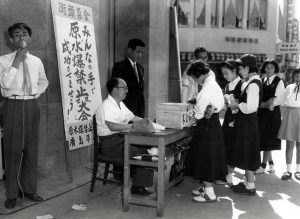Documenting Hiroshima 80 years after A-bombing: In June 1955, preparations begin for World Conference against Atomic and Hydrogen Bombs
Mar. 5, 2025
Fundraising campaign “with everyone’s support”
by Kyosuke Mizukawa, Senior Staff Writer
In June 1955, the Hiroshima Preparatory Committee for the World Conference against Atomic and Hydrogen Bombs, a gathering that was to be held in Hiroshima City in August, launched a fundraising campaign in front of Hiroshima Station and in the downtown area of Hatchobori (in the city’s present-day Naka Ward), calling for support of the event. Backed by growing public opinion nationwide for a ban on atomic and hydrogen bombs, the people of Hiroshima took to the streets.
Signature campaign spreads
Following the U.S. Bikini Atoll hydrogen bomb test in March 1954, signature campaigns calling for atomic and hydrogen weapons to be banned spread throughout Japan, with more than 20 million signatures collected nationwide by December of that year. In Hiroshima Prefecture, the number exceeded one million signatures by late August, and the citizen’s organization that had promoted the signature campaign developed into the Hiroshima Council against Atomic and Hydrogen Bombs in September.
The Hiroshima Council envisioned holding a world conference in Hiroshima to coincide with the 10th year anniversary of the atomic bombing. Individuals including Ichiro Moritaki, secretary-general of the council and a professor at Hiroshima University, proposed the world conference idea to the nationwide National Council for the Signature Campaign to Ban A- and H-Bombs and, in January 1955, the decision was formally made to hold the conference. Mr. Moritaki made a call for the conference with the following appeal.
“The conference should fundamentally be the first universal gathering of all humanity, transcending any and all differences in ideology, politics, religion, and social systems, to address the common destiny of humanity as it enters the nuclear age.”
The Hiroshima Preparatory Committee for the world conference was launched in May and garnered the participation of 128 local groups and individuals, including the Hiroshima Council against Atomic and Hydrogen Bombs, the Atomic Bomb Survivors Association, and the municipal federation of welfare commissioners. Mr. Moritaki assumed the post of secretary-general. The preparatory committee established an action plan that would “broaden the scope of its activities to ensure that anyone who opposed atomic and hydrogen bombs and resisted preparations for atomic war could freely participate, with a particular focus specifically on that point,” aiming at the participation of a wide range of citizens.
In hopes of raising awareness about the aims of the conference, the committee placed an emphasis on “door-to-door fundraising.” The committee members made donation envelopes on which were written the aims of the event, and the PTAs of the city’s elementary and junior high schools and youth groups called for cooperation in the form of 10-yen donations per household. The committee also organized street campaigns with placards held aloft reading, “Let’s work together to make this a success!” As a result, 810,000 yen was raised by July 30.
Appeal for recognition of reality of A-bombing damages
The preparatory committee also set about creating materials for the world conference to convey the reality of damages from the atomic bombing, receiving cooperation in that effort from local groups. The Atomic Bomb Survivors Association contributed the results of a survey of 44 A-bomb survivors selected from among its members. Half responded that they felt “sluggish and easily fatigued.” The survey also showed that quite a few people were unable to see a physician due to struggles in daily life despite exhibiting symptoms seemingly caused by the atomic bombing.
The Hiroshima Atomic Bomb Casualty Council (Gentaikyo), an organization formed in January 1953 by the Hiroshima City government, medical associations, and others, also collaborated in the preparation of materials. Hiroshima City estimated that around 6,000 A-bomb survivors were in need of medical treatment. It pointed out that, “The pain and suffering of those affected now by the atomic bombing will continue for decades to come, with new patients arising during that time,” calling for all medical costs to be borne by the national budget.
The number of people hoping to attend the world conference increased day by day. According to preparatory committee documents, the securing of adequate accommodations for participants was a topic of concern. However, women’s associations throughout the city made a proposal to “host participants in our homes and engage in discussions with each other.” Potential participants also expressed their hope of “staying in private homes and hearing directly from A-bomb survivors.” Women’s associations in the Nakajima Elementary School district near the main conference venue, the Hiroshima Municipal Auditorium, and other locations, accommodated a total of 600 people.
“Forgotten A-bomb survivors want to make an appeal to people around the world about their suffering over the last 10 years” was the headline carried in the Hiroshima Preparatory Committee bulletin dated August 1 as the start of the conference approached. The conference was held over the course of three days starting on August 6, 10 years after the atomic bombing. A total of 2,575 representatives from 46 prefectures and 97 national organizations throughout Japan as well as 52 representatives from 14 overseas countries participated in the world conference and listened directly to the voices of A-bomb survivors.
(Originally published on March 5, 2025)









